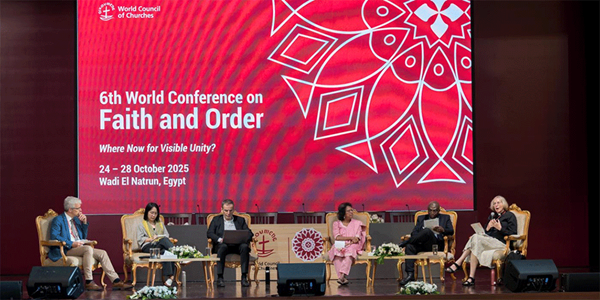“Where now for visible unity?” was the theme of the Sixth World Conference on Faith and Order meeting in Egypt from 24 to 28 October and on the final day of the gathering, a panel of theologians from different regions and contexts reflected on the topic of “Living Visible Unity.”
About 400 participants gathered for the conference, organized by the World Council of Church’s Commission on Faith and Order at the Logos Papal Center of the Coptic Orthodox Church in Wadi El Natrun.
“This conference invited us to ponder how the churches might respond afresh to Christ’s prayer ‘that they may all be one,’ amid new historical and contextual realities and in the continuing shadow of coloniality, whose enduring logics still shape our theologies, identities, and ecclesial relations,” said Rev. Dr Teddy Sakupapa, an ordained minister in the Uniting Presbyterian Church in South Africa.
Unity Leads to Shared Discipleship
“While churches flourish in South Africa, there are many issues that keep churches divided: different understandings of ministry; the ordination of women; contested questions around human sexuality; inequalities mirroring social fractures; political allegiances; and theological polarization that erodes the capacity of churches to speak and act with a common voice,” said Sakupapa. the current deputy moderator of the WCC Commission on Education and Ecumenical Formation.
“Unity, in my context,” said Sakupapa, “is less about structure and more about shared discipleship.”
The conference was the centerpiece of the WCC’s activities to mark the 1700th anniversary of the First Ecumenical Council of Nicaea, a key moment in the history of Christian faith and for the ecumenical journey today.
Suk Yi Pang, director of Ecumenical Relations for the Hong Kong Christian Council, reflected on how we regard the Ecumenical Council of Nicaea. “We remember it rightly as a triumph of unity—and yet we have developed a collective amnesia,” she said, describing what happened in Nicaea as being not a “final chapter” or a monument to uniformity but a single politically-charged scene.
“Diversity is difference within a shared system,” she said.
Love and Unity Are Markers for Genuine Christ-believers
“Why do I work for visible unity and yearn for it?” said Prof. Dr Athanasios Despotis, from the Ecumenical Patriarchate in Bonn in Germany, “I believe that love and unity are the identity markers of genuine Christ-believers. I recall Jesus’ action of washing the feet of all his disciples—including Peter, who later denied him, and Judas, who betrayed him.”
“Sri Lanka, as you may have seen in the news in the past decade, is known for its 30-year civil war—an ethnic conflict,” said Dr. Mano Emmanuel, senior lecturer and head of academic advancement at Colombo Theological Seminary. “The sign of visible unity in that context is that the church is the only religious community that brings together people from all ethnic groups. The Methodist Church and other churches are known for reconciliation efforts within the community—having participated in peace talks, having approached even terrorist groups to try and broker peace in the north during times of great conflict.”
Rev. Canon Prof. Dr Charlotte Methuen, professor of Church History at the University of Glasgow and an Anglican priest, stated “I have been reflecting that, in some ways, the story of Anglicanism over the past decades has often been seen as a story of disunity as we have wrestled with discussions around women’s ordination and around same-sex relationships.
Dr Johannes Oeldemann, a Roman Catholic who serves on the WCC Commission on Faith and Order, moderated the discussion. “From my point of view, visible unity is not a goal in a distant future at the end of a path toward Christian unity but something that arises while walking together and continues to grow with every step,” he said. “We have learned how important it is to be personally engaged for unity, making unity visible not only by striving for some distant future, but by living unity in the present—here and now.”
How Can You Help?
Your support of the Interdenominational Cooperation Fund apportionment allows our ecumenical partners around the world to speak out against atrocities such as war and poverty for those who don’t have a voice. Please encourage your leaders and congregations to support the Interdenominational Cooperation Fund apportionment at 100 percent.
World Council of Churches website
This story shows the power of the Ministerial Education Fund—one of seven apportionment funds of The United Methodist Church—to prepare and equip those answering God’s call to ministry. Your church’s support provides theological education, scholarships, and leadership development through our United Methodist seminaries and boards of ordained ministry. Together, we ensure that faithful, well-prepared leaders continue to guide the Church into the future.
When your church supports the Ministerial Education Fund, you invest in the next generation of United Methodist clergy and leaders.





